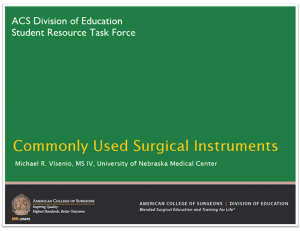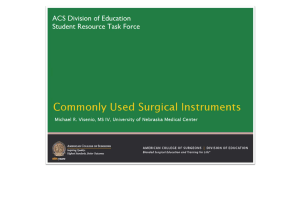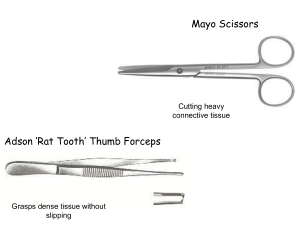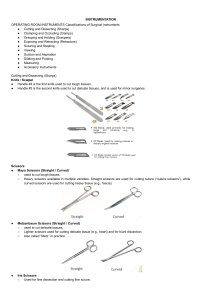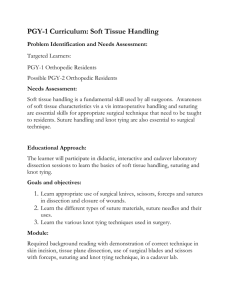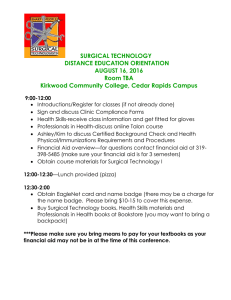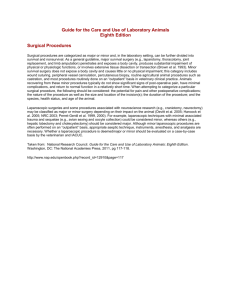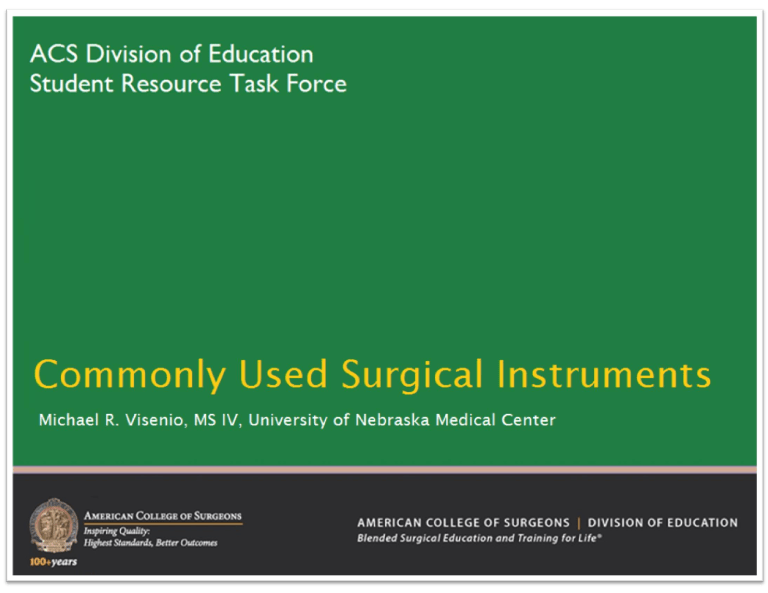
COMMON SURGICAL INSTRUMENTS The operating room contains a multitude of instruments fit for accomplishing a number of procedures. Note that this is not an exhaustive list of instruments, but rather some that you will encounter frequently. SCALPEL Used for initial incision and cutting tissue. Consists of a blade and a handle. Surgeons often refer to the instrument by its blade number. #10 Blade: Used primarily for making large skin incisions, e.g., in laparotomy. #11 Blade: Used for making precise or sharply angled incisions. #15 Blade: Smaller version of #10 blade used for making finer incisions. Pott’s Scissors: Fine scissors used for creating incisions in blood vessels. SCISSORS Used for cutting tissue, suture, or for dissection. Scissors can be straight or curved, and may be used for cutting heavy or finer structures. FORCEPS Also known as nonlocking forceps, grasping forceps, thumb forceps, or pick-ups. Used for grasping tissue or objects. Can be toothed (serrated) or nontoothed at the tip. CLAMPS Also called locking forceps, these are ratcheted instruments used to hold tissue or objects, or provide hemostasis. Can be traumatic or atraumatic. Mayo Scissors: Heavy scissors available in multiple varieties. Straight scissors are used for cutting suture (“suture scissors”), while curved scissors are used for cutting heavy tissue (e.g., fascia). Tissue Forceps: Non-toothed forceps used for fine handling of tissue and traction during dissection. Iris Scissors: Used for fine dissection and cutting fine suture. Originally for ophthalmic procedures, but now serves multipurpose role. Metzenbaum Scissors: Lighter scissors used for cutting delicate tissue (e.g., heart) and for blunt dissection. Also called “Metz” in practice. Bonney Forceps: Heavy forceps used for holding thick tissue (e.g., fascial closure). DeBakey Forceps: Used for atraumatic tissue grasping during dissection. Russian Forceps: Used for atraumatic tissue grasping during dissection. Adson Forceps: Forceps toothed at the tip used for handling dense tissue, such as in skin closures. Crile Hemostat: aka “snap,” atraumatic and nontoothed clamp used to grasp tissue or vessels that will be tied off. Also used in blunt dissection. Kelly Clamp: Larger size variation of hemostat with similar function for grasping larger tissues or vessels. Kocher Clamp: Traumatic toothed clamp used to hold tissue that will be removed. Allis and Babcock Clamps: Slightly rounded jaws, both are used for grasping intestine. ACS Division of Education Student Resource Task Force COMMON SURGICAL INSTRUMENTS NEEDLES & SUTURE Needles come in many shapes and cutting edges for various applications. Suture can be absorbable, non absorbable, and is available in different sizes. Needle Types Needles must dissect through tissue to pass suture. They come in various sizes, types, and shapes depending on the application. Here are a few (though not all) examples: Tapered Needle Needle is round and tapers to a simple point. Most commonly used in softer tissue such as intestine but may also be used in tougher tissue such as muscle. Needle Shape The shape of the needle is also important. The curvature of the needle allows for use in specialized applications. Curved needles are used in most general surgical procedures, while straight needles are used for skin and subcuticular suturing. Suture Sizing Available in sizes between #5 and #11-0. Higher numbers indicate larger suture diameter (e.g., #3 is larger than #2), and more zeros indicate smaller suture diameter (e.g., #4-0, or #0000, is smaller than #3-0, or #000). Conventional Cutting Needle Needle is triangular with sharp edges, and one edge faces the inside of the curved needle. Used for tougher tissues such as skin. Skin Glue and Staplers For skin closures, in particular, staplers and skin glue may be used in lieu of suture. This is usually based on cosmetic outcome and surgeon preference. Suture Types There are two main types of suture. The first is braided and non-braided, or monofilament. The second is absorbable and non-absorbable. Additionally, suture can be made with natural or synthetic materials. Some (brand) names and uses are shown below. Suture Types Absorbable Braided Non-Absorbable Monofilament Braided Monofilament Vicryl® Polysorb® Monocryl® Maxon® PDS® Chromic gut Silk Prolene® Surgipro® Monosof® Nylon Internal anastomosis Fascial closure Subcuticular skin closure Vessel ligation Skin closure Reapproximate lacerations RETRACTORS In varying forms, retractors are used to hold an incision open, hold back tissues or other objects to maintain a clear surgical field, or reach other structures. They can either be hand-held or self-retaining via a ratcheting mechanism. Army-Navy Retractor: Weitlaner Retractor: SelfDeaver Retractor: Used to gain exposure retaining for exposing deep Used to hold back or smaller surgical sites. the abdominal wall. of skin layers. Also called “Wheaty.” Richardson Retractor: Used to hold back deep tissue structures. Also called “Rich.” Bookwalter Retractor: Self-retaining retractor system that is anchored to the operating table. SUCTION Suction tips, combined with a suction source, help to remove debris and fluid from the surgical field. It can also be used to clear surgical smoke. Yankauer Suction Tube: Used primarily for surface suction and some intra-abdominal suction. Poole Suction Tube: Used to remove large amounts of fluid from the surgical field, as well as intra-abdominal suction. Frazier Suction Tip: Used primarily in ENT and neurosurgery. Usually angled. Malleable Retractor: Can be bent and customized. Also used to protect intestines during abdominal closure. Rake Retractor: Hand-held retractor with sharp teeth used to hold back surface structures. ACS Division of Education Student Resource Task Force COMMON SURGICAL INSTRUMENTS STAPLERS AND CLIPS Used for reanastomosis of viscera, vessel ligation, and excision of specimens. Can be one-time use, reloadable, manual, or electronically powered. Staples come in multiple sizes. Linear Stapler: Creates a linear staple line; no cutting function. Used in ligation and anastomosis. May be curved. Linear Cutter: Creates a linear cut and immediately staples both free edges. Used in separation and anastomosis. Circular Cutter: Performs circular cut and staple. Used in reanastomosis of hollow viscera, e.g., large bowel. Clips: Used in the ligation of vessels, may be metal or absorbable material. Open and lap applicators. ENERGY SYSTEMS Broad term used to describe various methods of cutting tissue or sealing vessels. May use electricity or sonic waves. Available in open or laparoscopic forms. Electrosurgery: Instrument that cuts or cauterizes tissue via an alternating electrical current. Open (shown) and laparoscopic (Ligasure®) applications. Ultrasonic: (Harmonic®) uses highfrequency sound to concurrently cut and seal tissue. Less thermal spread than electrosurgery, but more time consuming. Endostapler: Used in laparoscopic procedures, provides simultaneous cutting and stapling. May be manual or electronic. Some feature articulating heads to accomplish more difficult placement. LAPAROSCOPIC INSTRUMENTS Many instruments are similar to those used in open surgery, adapted to fit through narrow ports placed through the skin. Laparoscopic work is then conducted via the ports. Camera: The camera is the handheld component and connects to a variety of lenses. There are usually settings for focus and white balance. Lens: Available in multiple viewing angles to achieve better visualization of anatomical structures. May require occasional defogging. Image attributed to Magnus 1313 at English Wikipedia Insufflator: Injects carbon dioxide into the abdominal cavity to create a working space for trocar placement and surgical procedures. Veress Needle: One method of achieving pneumoperitoneum. Consists of blind placement of needle into abdomen and subsequent injection of gas. Trocars: Transabdominal working ports where laparoscopic instruments are inserted. Also for insufflation or removal of specimens. Available in multiple sizes, e.g., 5, 10, and 12 mm. Light Source: Fiber optic cable connects to lens and illuminates field of vision. Caution around internal structures as light output can be hot. Image attributed to Ignis Laparoscopic Instruments: Handheld and shafted implements used to work through trocars. Can perform grasping, retracting, cutting, cauterizing, and other functions. ACS Division of Education Student Resource Task Force SPECIAL SURGICAL CONSIDERATIONS Most surgical subspecialties have specialized equipment specific to the procedures they commonly perform. This guide provides a brief overview of some of that equipment for familiarity. CARDIOTHORACIC SURGERY Cardiopulmonary bypass, bronchoscopy, and equipment for minimally invasive thoracic procedures are frequently encountered. Image attributed to Pfree2014 Cardiopulmonary Bypass: Pump circuit that diverts blood away from heart, oxygenates blood, and removes wastes, with a separate circuit for cardioplegic solution. Operated by a cardiac perfusionist. Adequate anticoagulation required for proper function. Image attributed to Cancer Research UK Cystoscope: Endoscope, either flexible or rigid, that is used for visualization of the genitourinary system for either diagnosis or procedures. Combined with saline circulation to create viewing space in bladder. UROLOGIC SURGERY Minimally invasive cystoscopic equipment is frequently used for both visualization and performing procedures. Image attributed to Cancer Research UK Bronchoscope: Endoscope narrow enough to view, aspirate, or remove specimens from airway and branches Video-Assisted Thorascopic Surgery (VATS): Minimally invasive surgical technique for procedures in the thorax. Ureteral Stent: Semirigid tube that is used to maintain patency of ureter. May be used as temporary measure for obstruction or placed prior to abdominal surgery to identify ureters. Usually placed with cystoscopy. Image attributed to Hildpeyi at English Wikipedia Image attributed to Cancer Research UK ORTHOPAEDIC SURGERY Joint replacements and other procedures require specialized equipment. ROBOTASSISTED SURGERY Increasingly used for procedures in urology, gynecology, endocrine surgery, and other specialties. Image attributed to Arthroscopist Arthroscope: Endoscopic technique to diagnose and treat joint, ligament, and tendon disorders. Combined with saline circulation to create joint space. Image attributed to Bszsurgico Image attributed to Netha Hussain Orthopaedic Implants: Synthetic pins, nails, or other prostheses used to fix broken bones or replace worn joints. Usually implanted using special surgical equipment. Robotic Surgical System: Electronicallypowered instrument usually with multiple arms and interchangeable surgical tools. Surgeon works from a console while surgical technicians replace instruments as needed. System usually operates via laparoscopic approach. Rongeur: Sharp-edged and sturdy instrument used for removing bone or creating a window in bone. Surgeon Console: Operation center for surgical system, consisting of controls for robotic arms and stereotactic video offering threedimensional view of field. Bone Saw: Battery powered and used for cutting bone, either free hand or with the assistance of a jig. Robotic Arm: Apparatus holding surgical instruments. Allows for increased range of motion over laparoscopy through articulating instrument heads. ACS Division of Education Student Resource Task Force
